-
-
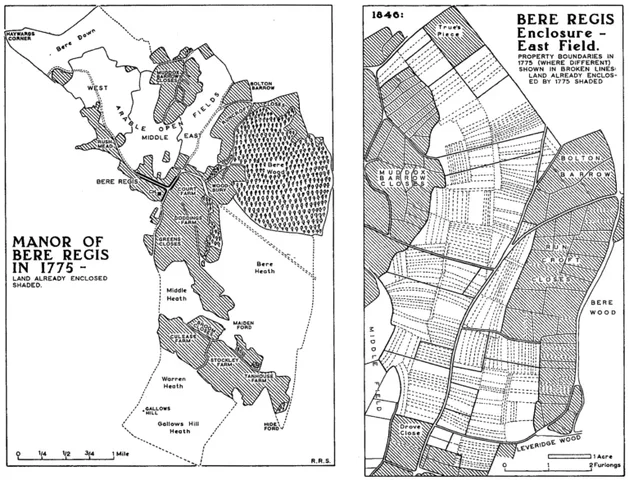 The Enclosure Acts in Britain privatized common farming lands and consolidated the land under wealthy landowners. This marked a major economic change because agriculture shifted from communal, subsistence farming to commercial production. Small farmers lost access to land and were forced to move into urban areas causing a rise in industrial labor forces. But, even with rises in productivity, this policy deepened social inequality and disrupted traditional life, shown in the economy hierarchy.
The Enclosure Acts in Britain privatized common farming lands and consolidated the land under wealthy landowners. This marked a major economic change because agriculture shifted from communal, subsistence farming to commercial production. Small farmers lost access to land and were forced to move into urban areas causing a rise in industrial labor forces. But, even with rises in productivity, this policy deepened social inequality and disrupted traditional life, shown in the economy hierarchy. -
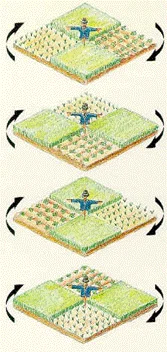 The Agricultural Revolution brought innovations like Townshend's crop rotation system. New techniques allowed for an increase in efficiency in food production allowing for populations to grow across Europe. It represented an economic change, moving agriculture toward science based productivity. It maintained continuity in Europe's agrarian foundation, farming stayed central to most people's livelihoods.
The Agricultural Revolution brought innovations like Townshend's crop rotation system. New techniques allowed for an increase in efficiency in food production allowing for populations to grow across Europe. It represented an economic change, moving agriculture toward science based productivity. It maintained continuity in Europe's agrarian foundation, farming stayed central to most people's livelihoods. -
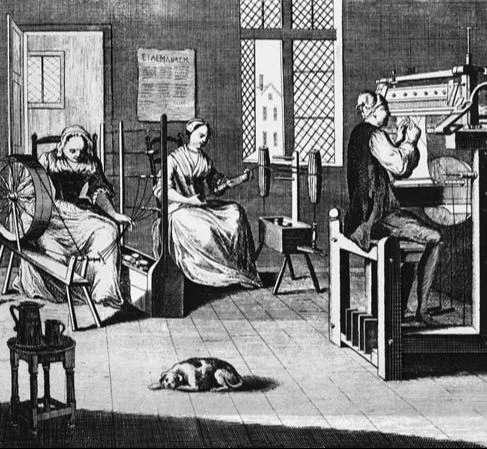 Before the Industrial Revolution, rural families produced textiles and goods in their homes from the putting-out system. Merchants supplied raw materials and collected finished products, this connected peasants to the early capitalist economy. This system represented economic change, as wage based labor replaced self-sufficient farming. However, there was a continuity in the use of family labor and the dependence on merchant control rather than full worker autonomy.
Before the Industrial Revolution, rural families produced textiles and goods in their homes from the putting-out system. Merchants supplied raw materials and collected finished products, this connected peasants to the early capitalist economy. This system represented economic change, as wage based labor replaced self-sufficient farming. However, there was a continuity in the use of family labor and the dependence on merchant control rather than full worker autonomy. -
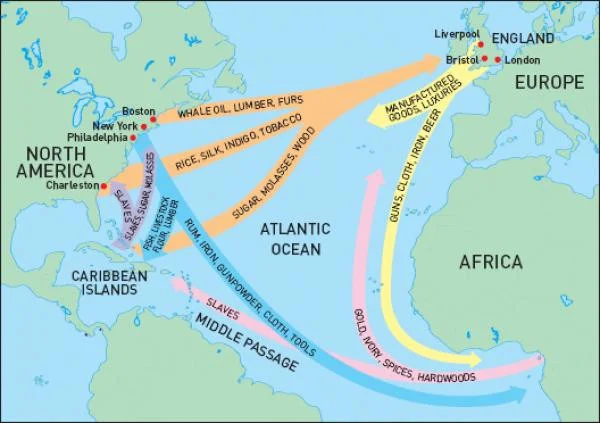 The expansion of the Atlantic slave trade and the Triangular Trade system changed Europe's economy. European nations imported raw materials like sugar, tobacco, and cotton while exporting manufactured goods and enslaved people. This was a mark for a massive economic change because the wealth shifted to port cities and commercial elites. However, this also showed the continuity in Europe's reliance on colonial exploitation for profit.
The expansion of the Atlantic slave trade and the Triangular Trade system changed Europe's economy. European nations imported raw materials like sugar, tobacco, and cotton while exporting manufactured goods and enslaved people. This was a mark for a massive economic change because the wealth shifted to port cities and commercial elites. However, this also showed the continuity in Europe's reliance on colonial exploitation for profit. -
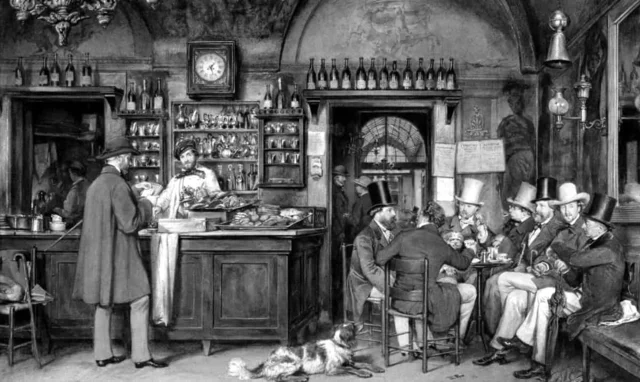 Because of the growing wealth from trade, Europeans began purchasing imported goods like tea, coffee, sugar, and textiles. The consumer revolution symbolized a cultural change because material possessions became a liaison to status and identity. Middle class families for the first time, engaged in the marketplace for luxury goods. However, continuity stayed in class divisions, peasants and the poor were mostly excluded from this culture of consumption.
Because of the growing wealth from trade, Europeans began purchasing imported goods like tea, coffee, sugar, and textiles. The consumer revolution symbolized a cultural change because material possessions became a liaison to status and identity. Middle class families for the first time, engaged in the marketplace for luxury goods. However, continuity stayed in class divisions, peasants and the poor were mostly excluded from this culture of consumption. -
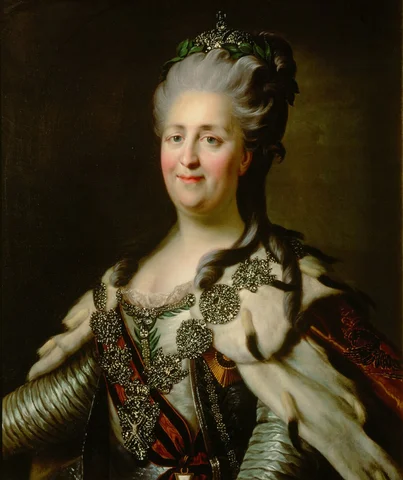 Rulers like Frederick the Great, Catherine the Great, and Joseph II established reforms inspired by the Enlightenment ideals; religious tolerance, education, and economic modernization. These policies showed social and political change as monarchs began to use reason and reforms to try to justify their power. However even though the monarchs still remained in absolute control, there was continuity in the dominance of hereditary rule. Their reforms modernized the economy, but not social equality.
Rulers like Frederick the Great, Catherine the Great, and Joseph II established reforms inspired by the Enlightenment ideals; religious tolerance, education, and economic modernization. These policies showed social and political change as monarchs began to use reason and reforms to try to justify their power. However even though the monarchs still remained in absolute control, there was continuity in the dominance of hereditary rule. Their reforms modernized the economy, but not social equality. -
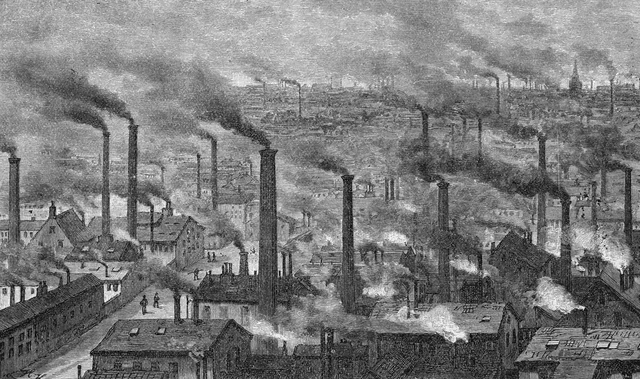 Enclosures and population growth pushed rural workers off the land while cities like Manchester and London grew rapidly. Urban laborers began working in factories or workshops, which signals a major social change toward industrial employment. This created overcrowded, unsanitary living conditions and new class divisions between owners and workers. The continuity of economic inequality stayed and the poor continued to be exploited, however now under a different system.
Enclosures and population growth pushed rural workers off the land while cities like Manchester and London grew rapidly. Urban laborers began working in factories or workshops, which signals a major social change toward industrial employment. This created overcrowded, unsanitary living conditions and new class divisions between owners and workers. The continuity of economic inequality stayed and the poor continued to be exploited, however now under a different system. -
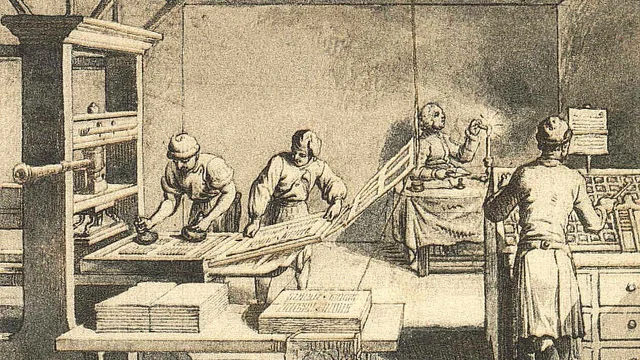
-

-
